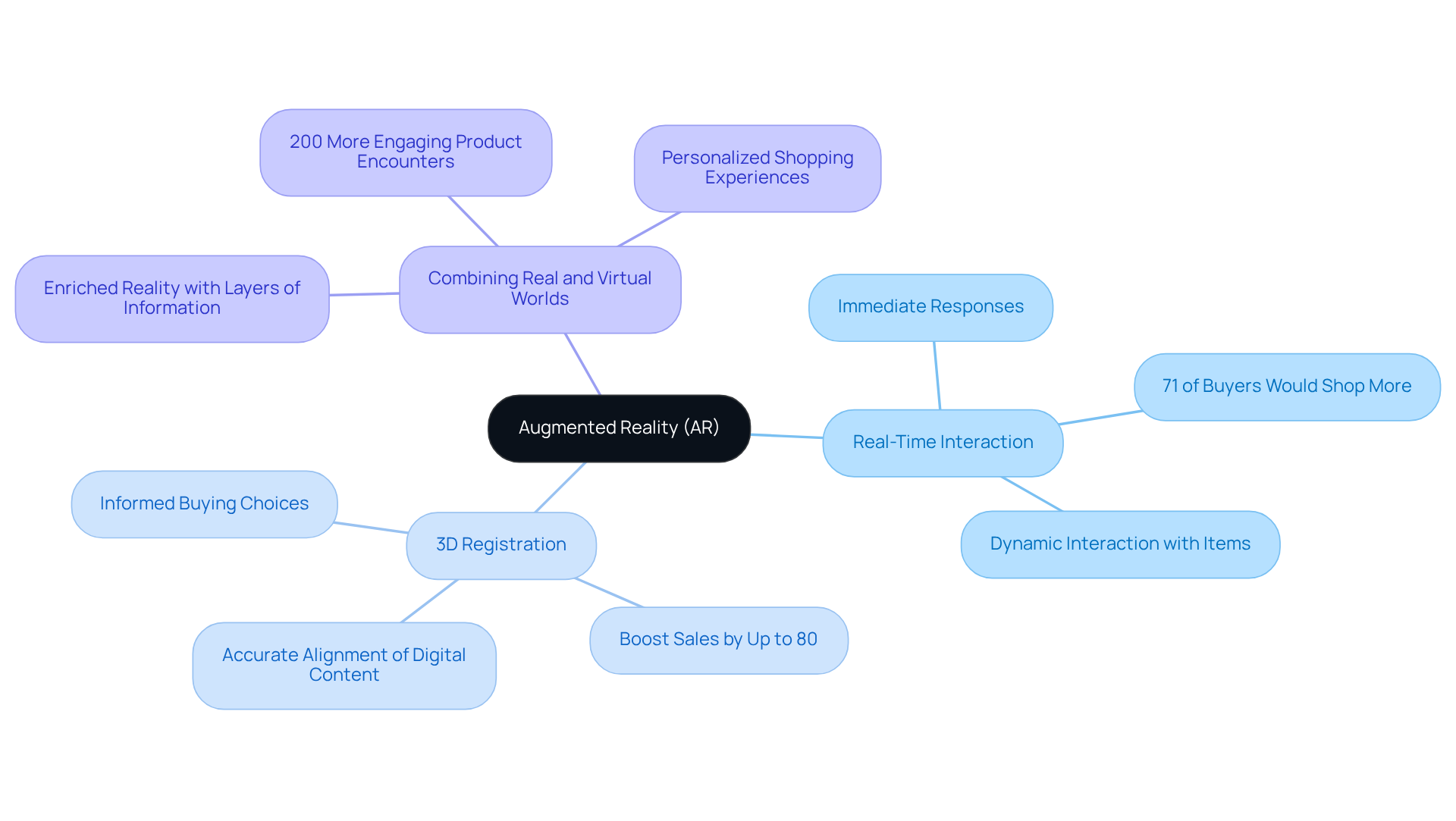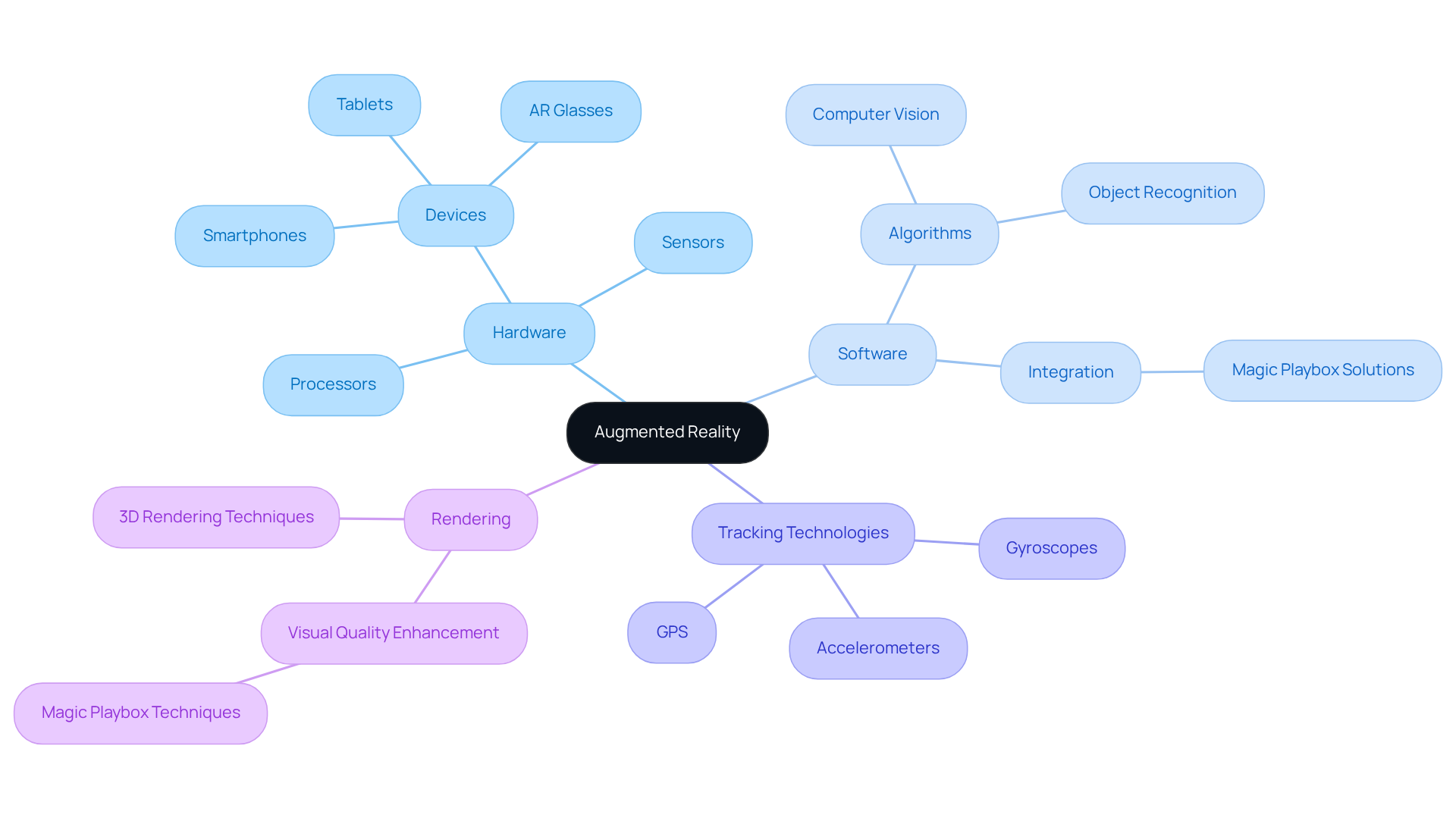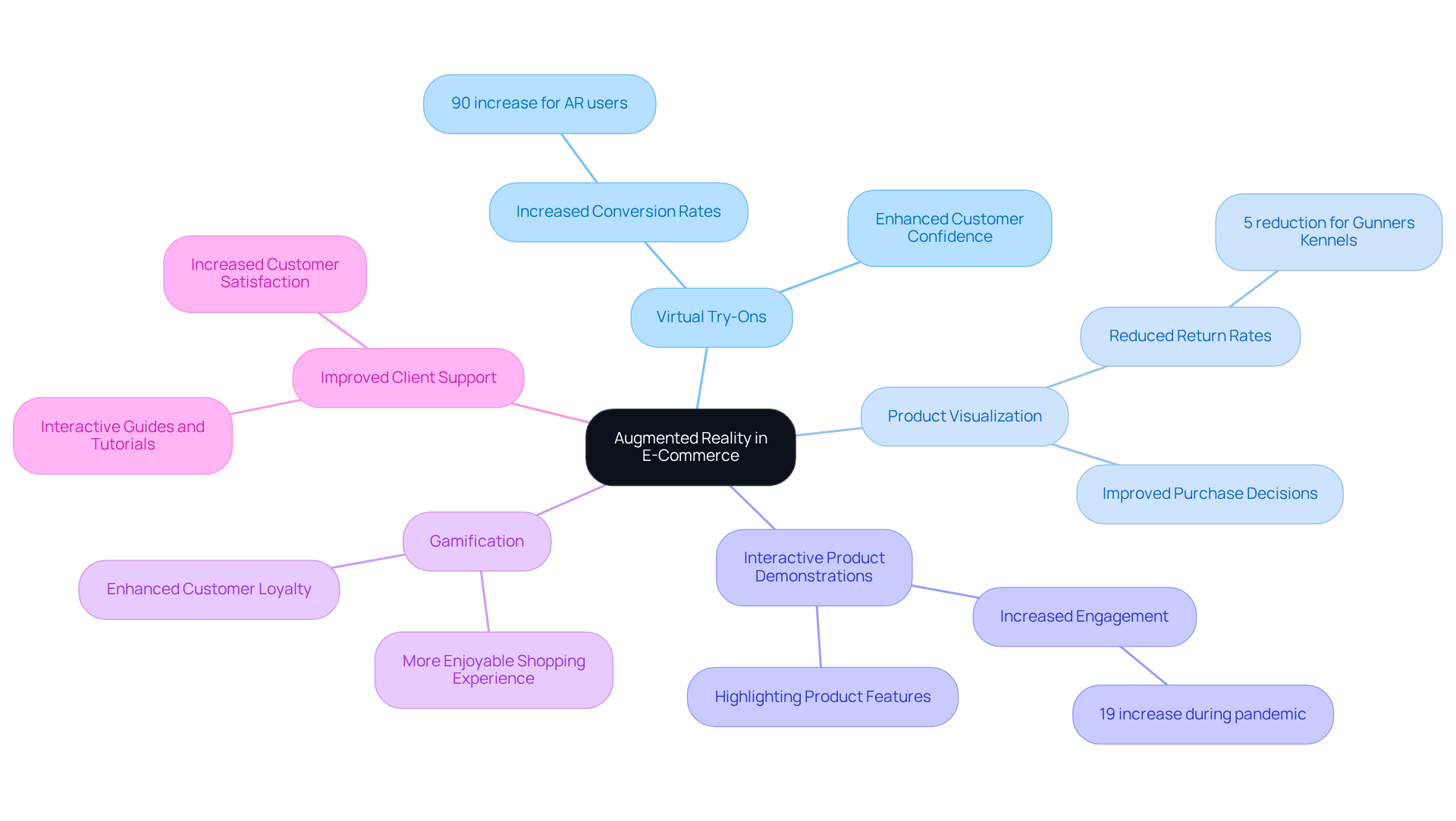Overview
Augmented reality revolutionizes e-commerce by seamlessly overlaying digital information onto the real world. This innovative approach enhances user interaction through features such as:
- Virtual try-ons
- Product visualization
- Interactive demonstrations
Research indicates that AR's real-time interaction and precise 3D registration lead to increased customer engagement and significantly higher conversion rates. In fact, statistics show that AR can boost sales by up to 80% while simultaneously reducing return rates. For brand managers seeking to elevate their customer experience, leveraging augmented reality is not just an option; it is a proven strategy that delivers measurable results.
Introduction
Augmented Reality (AR) is revolutionizing the e-commerce landscape by merging digital experiences with the physical world, fundamentally altering how consumers engage with products. This technology presents a unique opportunity for brands to enhance customer interaction, providing immersive experiences that can significantly boost sales and reduce return rates.
Research indicates that brands utilizing AR not only attract customers but also foster loyalty in an increasingly competitive market. However, as AR continues to evolve, questions arise about its effectiveness and the best practices for implementation.
How can brands harness the power of AR to not only attract but also retain customers? This is a critical consideration for those aiming to thrive in the dynamic e-commerce environment.
Define Augmented Reality and Its Core Principles
Augmented Reality (AR) represents a transformative technology that overlays digital information—images, sounds, and sensory stimuli—onto the real world, allowing us to explore how does augmented reality work in significantly enhancing user interaction and perception. The core principles driving AR's effectiveness in e-commerce are as follows:
-
Real-Time Interaction: AR systems deliver immediate responses to user inputs and environmental changes, fostering a seamless integration of digital and physical worlds. This capability allows customers to interact dynamically with items, thereby improving their shopping journey. Notably, a significant 71% of buyers indicate they would shop more frequently if AR technology were readily available, underscoring the growing consumer demand for immersive shopping experiences.
-
3D Registration: Accurate alignment of digital content with physical objects is crucial in AR. This principle ensures that virtual elements appear firmly situated in the real world, enabling users to understand how does augmented reality work in integrating items into their surroundings—an essential factor for informed buying choices. Research indicates that AR modules can boost sales by up to 80%, demonstrating the effectiveness of immersive technology in driving customer action.
-
Combining Real and Virtual Worlds: AR enriches reality by adding layers of information, allowing users to interact with both digital and physical elements simultaneously. This interaction cultivates a more immersive shopping environment, as evidenced by the statistic that AR product encounters are 200% more engaging than traditional methods.
Industry leaders emphasize how does augmented reality work in enhancing the significance of real-time interaction. The integration of AR with AI facilitates personalized shopping experiences, which not only reduces the need for returns but also minimizes environmental impact. As online retail evolves, the incorporation of AR enhances client engagement and boosts conversion rates, establishing it as a vital tool for brands aiming to innovate in the digital marketplace. Magic Playbox stands at the forefront of this innovation, pioneering immersive AR solutions that enhance brand engagement and customer loyalty. The global AR market is projected to reach USD 97.8 billion by 2028, highlighting the critical role of AR in the future of online retail.

Explain the Technical Mechanisms Behind Augmented Reality
To understand how augmented reality works, it's important to recognize that the technical mechanisms behind it encompass several key components that function cohesively to deliver immersive experiences in e-commerce, particularly through the innovative solutions provided by Magic Playbox.
-
Hardware: AR necessitates devices equipped with cameras, sensors, and processors. Common platforms, including smartphones, tablets, and AR glasses, facilitate the interaction between the digital and physical realms, enabling users to engage with content seamlessly.
-
Software: AR applications utilize advanced algorithms for computer vision, allowing for the recognition of physical objects and environments. This software processes information from the device's sensors to accurately overlay digital content, thereby enhancing user interaction. Magic Playbox's proprietary software solutions exemplify this by ensuring seamless integration of AR content across various e-commerce platforms.
-
Tracking Technologies: Various tracking methods, such as GPS, accelerometers, and gyroscopes, are employed to ascertain the user's position and orientation in real-time. This guarantees proper alignment of digital components with the physical setting, resulting in a smooth interaction. Magic Playbox leverages cutting-edge tracking technologies to elevate user engagement and interaction.
-
Rendering: Once the software identifies the environment, it renders digital objects in 3D, ensuring realistic interaction with the physical world. This rendering process is vital for crafting believable and engaging AR experiences. Magic Playbox's rendering techniques have been shown to significantly enhance the visual quality of AR applications, making them increasingly appealing to consumers.
Collectively, these mechanisms enhance user involvement in online shopping by enabling customers to visualize items within their own settings, which illustrates how augmented reality works to lead to more informed purchasing decisions. Research indicates that items promoted with AR content experience 94% greater conversion rates compared to those lacking such features, underscoring the substantial impact of AR on online retail success. Furthermore, case studies, such as Oakywood's implementation of AR technology, resulted in a remarkable 250% increase in sales of essential items, showcasing the tangible advantages of integrating AR into retail strategies. This serves as a testament to the efficacy of solutions offered by Magic Playbox.

Explore Practical Applications of Augmented Reality in E-Commerce
Augmented Reality (AR) presents a multitude of practical applications in e-commerce that significantly enhance the shopping experience and drive sales conversion rates:
-
Virtual Try-Ons: AR technology allows individuals to virtually try on clothing, accessories, or makeup, providing a realistic view of how products will appear before purchase. Research indicates that understanding how does augmented reality work can increase conversion rates by up to 90% for consumers who engage with AR, fostering greater confidence in their buying decisions. Magic Playbox's innovative AR solutions exemplify this trend, demonstrating how does augmented reality work by enabling brands to create immersive virtual try-on interactions that resonate with consumers.
-
Product Visualization: With AR, clients can visualize how furniture or decor items will fit into their homes, effectively bridging the gap between online shopping and in-store experiences. This visualization not only boosts customer confidence but also reduces return rates, as it helps shoppers understand how does augmented reality work, enabling them to make more informed choices about their purchases. For instance, Gunners Kennels reported a 40% increase in order conversion rate after implementing AR, demonstrating its impact on e-commerce. Magic Playbox's advanced AR tools provide insights into how augmented reality works, further enhancing this capability and enabling brands to display their offerings in a more engaging manner.
-
Interactive Product Demonstrations: Brands can leverage AR to create engaging interactions that highlight product features and benefits. This interactive method assists clients in grasping the value of offerings, resulting in increased engagement and satisfaction levels. Magic Playbox's expertise in creating these interactions demonstrates how does augmented reality work, positioning them as a leader in the AR sector.
-
Gamification: By incorporating AR into shopping experiences, brands can gamify the purchasing process, making it more enjoyable and promoting engagement, which raises the question of how does augmented reality work. This strategy not only enhances engagement but also fosters a sense of loyalty among consumers. Magic Playbox's innovative gamification strategies demonstrate how does augmented reality work in enhancing client retention.
-
Improved Client Support: AR can offer interactive guides or tutorials, enhancing clients' comprehension of how to utilize products effectively. This support can lead to heightened satisfaction and repeat business, as clients feel more empowered and informed. Significantly, 93% of Snapchat users express enthusiasm for utilizing AR for shopping, highlighting the increasing consumer demand and prompting the question of how does augmented reality work in enhancing these interactions.
These applications of AR not only enhance the shopping experience but also raise the question of how does augmented reality work to boost customer satisfaction and loyalty, positioning brands for greater success in the competitive online marketplace. Furthermore, with the number of AR users projected to reach 1.7 billion globally by the end of the year, the relevance of AR in e-commerce strategies is set to grow even further.

Conclusion
Augmented Reality (AR) is revolutionizing the e-commerce landscape by merging digital and physical experiences, creating a more engaging shopping environment for consumers. This technology not only enhances user interaction but also significantly impacts purchasing decisions, as evidenced by growing statistics around customer engagement and sales conversion rates. By leveraging AR, brands can offer innovative solutions that cater to the evolving demands of shoppers, ultimately reshaping the online retail experience.
Key insights from the exploration of AR in e-commerce reveal its multifaceted applications, including:
- Virtual try-ons
- Product visualization
- Interactive demonstrations
- Gamification
- Improved client support
Each of these applications serves to enhance the consumer's journey, fostering greater confidence in purchasing decisions and leading to a reduction in return rates. The integration of AR technologies, particularly through platforms like Magic Playbox, showcases the potential for increased engagement and loyalty among consumers, highlighting the effectiveness of immersive shopping experiences.
The significance of AR in e-commerce cannot be overstated. It not only meets the current consumer demand for interactive and personalized experiences but also positions brands for future success in a rapidly evolving digital marketplace. As the AR market continues to expand, embracing this technology is crucial for companies seeking to enhance customer satisfaction and drive sales. Brands are encouraged to explore the vast potential of AR to transform their e-commerce strategies and foster deeper connections with their audience, ensuring they remain at the forefront of retail innovation.
Frequently Asked Questions
What is Augmented Reality (AR)?
Augmented Reality (AR) is a transformative technology that overlays digital information, such as images, sounds, and sensory stimuli, onto the real world, enhancing user interaction and perception.
What are the core principles of Augmented Reality?
The core principles of Augmented Reality include Real-Time Interaction, 3D Registration, and Combining Real and Virtual Worlds. These principles enhance user experience and engagement in various applications, particularly in e-commerce.
How does Real-Time Interaction benefit users in AR?
Real-Time Interaction allows AR systems to provide immediate responses to user inputs and environmental changes, fostering a seamless integration of digital and physical worlds, which improves the shopping journey for customers.
What impact does 3D Registration have on Augmented Reality?
3D Registration ensures the accurate alignment of digital content with physical objects, allowing users to see virtual elements as if they are part of the real world. This principle is crucial for making informed buying choices.
How does AR enhance the shopping experience?
AR enriches the shopping experience by allowing users to interact with both digital and physical elements simultaneously, creating a more immersive environment. AR product encounters are reported to be 200% more engaging than traditional methods.
What are the benefits of integrating AR with AI in e-commerce?
The integration of AR with AI facilitates personalized shopping experiences, which can reduce the need for returns and minimize environmental impact, thereby enhancing client engagement and boosting conversion rates.
What is the projected growth of the global AR market?
The global AR market is projected to reach USD 97.8 billion by 2028, indicating the critical role of AR in the future of online retail.
How does Magic Playbox contribute to Augmented Reality innovations?
Magic Playbox is at the forefront of AR innovation, pioneering immersive solutions that enhance brand engagement and customer loyalty in the digital marketplace.




